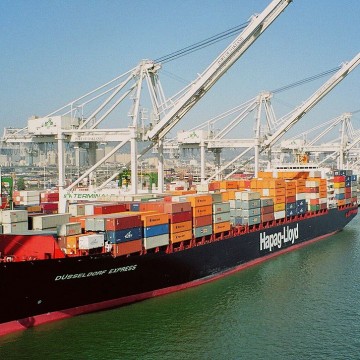forum
library
tutorial
contact

Lack of Ships Visiting Portland
Likely to Hurt Metro's Export Gains
by Rebecca Randall
Go Local PDX, July 23, 2015
|
the film forum library tutorial contact |

|
Lack of Ships Visiting Portland
by Rebecca Randall
|
 The Westwood Rainier began loading for export out of Terminal 6's container pier on Tuesday --the first ship in the terminal since the Port of Portland lost two of its major shipping lines, first Hanjn in February and then Hapag-Lloyd in April due to labor disputes. The event could help pick up business at the port, but the outlook for 2015 is looking low compared to the $18.6 billion the Portland metro area exported in 2014.
"Westwood is a smaller ship, and they are taking some boxes for export, but we're sort of interested to see how the event goes and the success of the loading," said Port of Portland spokesman Kenny Macdonald.
The Westwood Rainier began loading for export out of Terminal 6's container pier on Tuesday --the first ship in the terminal since the Port of Portland lost two of its major shipping lines, first Hanjn in February and then Hapag-Lloyd in April due to labor disputes. The event could help pick up business at the port, but the outlook for 2015 is looking low compared to the $18.6 billion the Portland metro area exported in 2014.
"Westwood is a smaller ship, and they are taking some boxes for export, but we're sort of interested to see how the event goes and the success of the loading," said Port of Portland spokesman Kenny Macdonald.
For now, Westwood Shipping plans on making a monthly stop at the Port of Portland.
The outlook for 2015 is particularly sobering in light of the positive data from 2014 as well as the region's goal to double exports by 2017.
According to the International Trade Administration, in 2014 the Portland-Vancouver-Hillsboro metro area was the country's 20th largest export market and increased its exports by six percent over 2013 numbers. In fact, 2014 moved the fifth highest tonnage of all time, according to Bill Wyatt, director of the Port of Portland. The metro area includes Washington County, Multnomah County, Clark County, Clackamas County and Yamhill County, Columbia County, and Skamania County.
The data does not include exports for the whole state of Oregon or goods originating in another state. "Generally speaking, lots of products that are produced in Oregon could conceivably be shipped down to Oakland or the Bay Area or anywhere else," said Macdonald.
"Before we lost service with the major container carriers, we were also shipping hay and sent either by barge or by truck down to Terminal 6 to be sent to Asia for animal feed," he said.
Macdonald said that one could imagine an Oregon farmer who used to send three containers of hay to Portland in a one-day trip. Now, he has to take it to Seattle, which raises his shipping costs and takes more time. "They are working around it, but none of (the scenarios) are as ideal as having regular service on Terminal 6."
While agricultural products are the second most exported goods out of the Portland area, computers and electronic parts actually dominate, contributing $7.846 million to the economy or about 42 percent of the exported goods.
Products from technology companies most probably ship via air cargo, said Macdonald.
Other exports in the top five include machinery, transportation equipment and chemicals. The Portland area also exports of primary metal manufactures, processed foods, wood, electrical equipment, appliances and components.
The slow down at the port also comes at a time when Portland has been actively trying to increase its exports. The Greater Portland Export Initiative, launched in 2012, aims to double exports and grow 103,000 new jobs during the five years since 2012. The initiative is supported by the Brookings Institution, a national think tank that selected Portland as one of four cities it will help boost exports.
Since the recession, the city has been working to increase exports through Greater Portland Inc., the Portland Development Commission and others. However, although the slowdown in Terminal 6, will be a setback in the progress made over the last few years, there are many other goods that can still be shipped via sea out of Portland, including autos, grains, minerals and "breakbulk" or non-container goods, like large machinery or steel plates. In fact only about 15 percent of cargo tonnage out of the Port of Portland is container shipping, although that amount is difficult to quantify in dollars. "It represents a smaller portion of the total shipping out of the Port of Portland," said Macdonald, "But it affects a larger group of shippers who are trying to ship to the rest of the world."
The loss of Hanjin and Hapig-Lloyd meant 650 waterfront jobs were lost and impacted more than 1,000 Oregon companies that need those services, most of which were small- to medium-size businesses. In total, international trade supports about 268,000 jobs in the city of Portland.
"Our biggest challenge will be to restore confidence -- from producers, shippers and shipping lines. Locally, we must create a shared vision of how we can transform the terminal into the most cost efficient terminal in the PNW," said Wyatt during the annual Gateway to the World luncheon in April.
This summer Oregon Trade Solutions is kicking off a series of discussions with exporters and importers around the state in a quest to find interim solutions to the problems with container service at Terminal 6. The first meeting is Friday, July 24, 9 a.m. to noon at the Sheraton Portland Airport Hotel, 8235 NE Airport Way.
learn more on topics covered in the film
see the video
read the script
learn the songs
discussion forum
